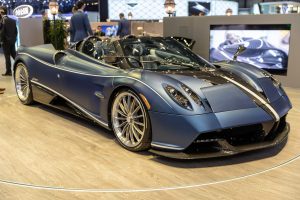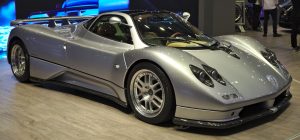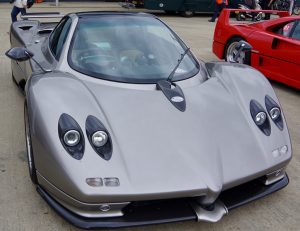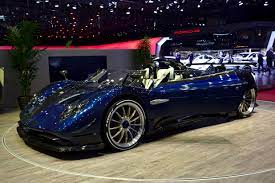The first ever rendition of the Pagani Zonda debuted at the 1999 Geneva Motor Show, and it has since been a staple in the supercar industry. Its effortless beauty and jaw-dropping speeds are mere drops in the metaphorical bucket when listing the positives surrounding this brilliant vehicle.
Originally, it was going to be named the ‘Fangio F1,’ after Formula One legend Juan Manuel Fangio. Unfortunately, his untimely death came in 1995, and this meant that Pagani renamed the car the Zonda, taking its name from the Zonda wind, which is a regional term used to describe a hot air current above Argentina. After the Zonda came the Huayra, named so after Huayra-tata, a Quecha wind god. However, the ever-brilliant Huayra is a story for another day.

The Zonda C12 was the first supercar that was constructed at the atelier in San Cesario sul Panaro, a moderately-sized municipality in Italy. The place itself is now home to the ‘Museo Horacio Pagani,’ dedicated of course to Horacio Pagani, the founder of the company. The C12’s design was revolutionary to say the least. Its bodywork was inspired by the sleek Mercedes C11, with its sharp appearance, angular edges and beautiful 4-stroke exhaust system. Pagani had created a sight-to-behold, and it wasn’t just brilliant in terms of appearance. Installed into the car was a carbon fibre monocoque, which greatly reduced weight, and this was complemented by a Mercedes-Benz AMG engine, which was capable of generating an astonishing 394 horsepower. Such high performance is made attainable by mounting the V12 Mercedes engine in a central position, as this simultaneously increases torque and power whilst reducing weight and distributing it evenly. Pagani also used state-of-the-art composite materials for the chassis as well as the majority of the bodywork, making excellent use of carbon fibre. Again, this reduces weight whilst retaining key points of rigidity should the car come into any kind of collision. Driver comfort was also made a priority, with the interior of the Zonda C12 being lined with leather and even suede in some specific areas. The dashboard wasn’t cluttered with a heap of unnecessary dials and features, and the steering wheel was classy, and intricate, yet beautifully simple. Pagani had managed to do with the C12 what no other supercar had done before; combine fashion with function.

The next step in the line of Pagani Zonda’s was the Zonda S, also referred to as the Zonda S 7.3, due to its 7.3 litre capacity V12 Mercedes-AMG engine. This magnificent, exclusive engine is capable of outputting 555 horsepower, making the Zonda S a force to be reckoned with. Unlike the largely carbon fibre Zonda C12, the Zonda S is mostly supported by a molybdenum-chrome chassis, and the suspension is made up of aluminium. This allows the car to glide over rougher road surfaces without relinquishing its incredible levels of grip and stability. Furthermore, the carbon fibre seat and leather lining means the Zonda S keeps the luxurious comfort of the C12. An added bonus is the silence of the V12 engine when inside, thanks to the terrific sound insulation. This propels driver comfort to the maximum. The exterior design of the Zonda S is where it truly shines, with its aggressive angles, jutted out headlights and sleek overall shape, the car possesses the appearance of a blade seamlessly slicing ribbons through the air.

Since the Zonda S, there have been many different renditions of the Zonda – seven individual ones to be precise, with the a few one-offs and special editions scattered in between. Perhaps most remarkable of all the Zondas is the HP Barchetta, which was unveiled in 2017 as a 60th birthday present for the company’s founder, Horacio Pagani. It also commemorated the 18th anniversary of the Zonda itself. This unique model has several differences in terms of the exterior design, making it rather different from all other Zondas. Most noticeable, perhaps, is the ‘barchetta’ body style, loosely translating to ‘little boat,’ in Italian, thanks to its flat structure and open top. It also had rear wheel covers which were inspired by racing cars, making this the first ever Pagani to base itself off of such styling. Moreover, the HP Barchetta features a sizeable rear spoiler, air intakes and rear lights all sourced from the 760 series cars. Power is provided by the extraordinary 7.3 litre Mercedes-Benz V12 engine which could produce 789 horsepower. This stamps the HP Barchetta as the most powerful road-legal Zonda Pagani have ever produced.

Overall, each rendition of the Pagani Zonda has been a masterclass in automotive engineering. They’re so successful because they embody the spirit of Pagani, they don’t try to be something they aren’t like so many other supercar manufacturers. Pagani’s are quintessentially… Pagani’s. They’re fast and powerful and aggressive, yet they’re also comfortable, and elegant, and majestic. The Zonda has stood the test of time, it’s battled against competitors, whether it be via aesthetic comparisons, or performance, and it’s won almost every time. It’s a timeless supercar which is considered as one of the best of all-time, and rightfully so.




Follow us to keep up-to-date using our social networks
Enter your email address to sign up to our newsletter to keep up-to-date.




